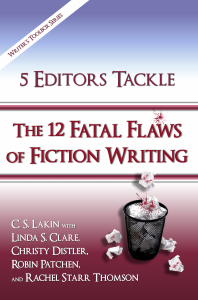The Fatal Flaw of Underwriting
 Hi everyone–I hope you had a terrific weekend and are in the mood to learn. Today I’m handing over the blog keys to Rachel Starr Thomson, one of the editors who have jointly written 5 Editors Tackle the 12 Fatal Flaws of Fiction Writing. I’m excited about this venture of Rachel’s as the book features more than sixty detailed Before and After examples of flawed and corrected passages to help authors learn to spot flaws in their writing. Seeing real examples is a great way to elevate your writing.
Hi everyone–I hope you had a terrific weekend and are in the mood to learn. Today I’m handing over the blog keys to Rachel Starr Thomson, one of the editors who have jointly written 5 Editors Tackle the 12 Fatal Flaws of Fiction Writing. I’m excited about this venture of Rachel’s as the book features more than sixty detailed Before and After examples of flawed and corrected passages to help authors learn to spot flaws in their writing. Seeing real examples is a great way to elevate your writing.
The Fatal Flaw of Underwriting
Fundamentally, when we write a story, we want to connect with readers’ emotions. Engage emotion. Elicit it. Give readers a story they don’t just learn but one they feel and will never forget.
Yet emotion is one of the story elements most commonly underwritten—and underwriting in general tends to harm emotional connection the most.
Underwriting is just what it sounds like: it’s the failure to put things on the page that need to be there. When somebody picks up a gun and fires it off, and we didn’t know there was a gun on stage, that’s underwriting. When someone makes a decision completely out of the blue, leaving us not so much surprised as confused, that’s underwriting. When a story just plain doesn’t make sense, it’s probably underwritten.
And when no matter how hard you try, you just can’t give a damn about the characters? Most likely underwriting is at fault.
Why We Underwrite
The dirty little secret, though? Underwriting is sometimes (often) a direct result of following editorial advice like “show, don’t tell,” and “make sure your scenes are active and full of conflict” and “don’t info dump or fill your scenes with backstory.”
As an editor who also writes stuff (a lot of stuff), allow me to eat humble pie and tell you that sometimes we push you to strip so much out of your story that it ends up gasping for breath, struggling to hang on to a shred of character or conflict that anyone cares about.
I’ve been there. I once misinterpreted “show don’t tell” so horrendously that I thought it meant everything had to be conveyed through action and dialogue alone, and I was never allowed to include thoughts or backstory. Talk about gutting a book!
Connecting
Underwriting hurts emotional connection so badly because it turns everything 2D. We lose contact with really essential parts of our stories, settings, and characters when we fail to include what needs to be there.
In particular, these three often-underwritten areas can make or break connection:
Process. When your character goes from decision point A (“I will not go to the ball”) to decision point B (“I will go to the ball”), and we didn’t see any of the decision process, it’s impossible to feel invested in the question. The Rule of Three is helpful here: in a decision of midlevel importance (meaning it’s more important than “I think I’ll brush my teeth” and less important than “I think I’ll marry the hero after all”), show three stages of the decision-making progress.
I will not go to the ball.
But then I just learned my best friend is going.
If my best friend goes, she will exceed my popularity.
If she exceeds my popularity, I will lose the interest of the prince.
I will go to the ball after all.
Reaction. In my clients’ manuscripts, it’s amazing how often something will happen that ought to get a reaction from the POV character … and it doesn’t. I mean, somebody’s mother might have just died, and we get crickets. When you’re in POV you always always always have to react. Even if you don’t react, it has to be because you’re being so darn deliberate about not reacting. If the temperature drops, shiver. If someone dies, cry. If someone says something provocative, have an opinion about it.
Many times, I’ve had a client return a manuscript after revision, and simply by adding reaction—usually in the form of a thought, shown through deep POV—they had absolutely transformed the story. A character who responds to things is alive, and through that character, the story can be experienced at far greater depth.
The Thoughts Behind Emotion. This is a biggie, and it’s where “show don’t tell” can be so incredibly damaging when misunderstood. We know not to write “She was angry.” So instead, many writers revert to writing “body emotions”: “She ground her teeth.” “She turned red.” This makes for a lot of odd and sometimes unclear images, but it doesn’t connect us to the character’s emotion at all. We see her feeling something; we don’t feel it. The best way to convey emotion, it turns out, is to write thoughts. We feel in response to things we’re thinking. So do our characters. If you can show what they are thinking, nine times out of ten you can make an emotional connection with your readers.
Words are the stuff of our worlds. Without words to translate into vivid images, actions, thought processes, emotions, settings, and more, none of those things can exist. So underwriting is actually as great a danger to a novelist as overwriting—perhaps even a greater one.
Thankfully, underwriting not irreparable. In fact, when we go and fill in the gaps, we might just discover the missing heart of our own stories.
 Rachel Starr Thomson is the author of eighteen novels. As an editor and writing coach, she has helped writers achieve their best work for over a decade—so she’s thrilled to contribute to The Writer’s Toolbox series, which gives fiction writers everything they need to know to create compelling, solid stories, with 5 Editors Tackle the 12 Fatal Flaws of Fiction Writing.
Rachel Starr Thomson is the author of eighteen novels. As an editor and writing coach, she has helped writers achieve their best work for over a decade—so she’s thrilled to contribute to The Writer’s Toolbox series, which gives fiction writers everything they need to know to create compelling, solid stories, with 5 Editors Tackle the 12 Fatal Flaws of Fiction Writing.
You can check out all Rachel’s books at her website.
Which of these three areas of underwriting do you struggle with? Let us know in the comments!
The post The Fatal Flaw of Underwriting appeared first on WRITERS HELPING WRITERS™.
Writers Helping Writers
- Angela Ackerman's profile
- 1014 followers



